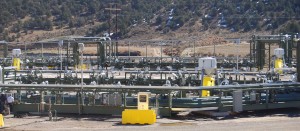
by David Frey | May 9, 2011 | Environment, News, The West

Shell's experimental oil shale facility in western Colorado. David Frey photo.
 To boosters, it’s almost a magical elixir for the world’s energy woes. To opponents, it’s more akin to snake oil. Even more than most other fossil fuels, oil shale meets with a sharply divided reaction, and after two weeks of public hearings across Utah, Wyoming and Colorado, federal officials have received an earful from both sides.
To boosters, it’s almost a magical elixir for the world’s energy woes. To opponents, it’s more akin to snake oil. Even more than most other fossil fuels, oil shale meets with a sharply divided reaction, and after two weeks of public hearings across Utah, Wyoming and Colorado, federal officials have received an earful from both sides.
But beyond the bluster, those in the middle feel left in a vacuum of straight talk. (more…)
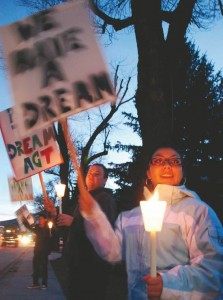
by David Frey | May 1, 2011 | Boom and Bust, News, The West
 ASPEN JOURNALISM
ASPEN JOURNALISM
Aspen Journalism is an independent nonprofit news organization.
The region’s growing Hispanic population likely will force county clerks in Pitkin, Eagle and Garfield counties to publish bilingual ballots for the first time ever.And as Hispanics make up a larger and larger population of potential voters, both Democrats and Republicans are looking to Latino voters to boost their parties.
Under the 1973 Voting Rights Act, areas with large Hispanic, Asian, American Indian and Alaskan native groups must provide bilingual voting materials and bilingual poll workers.
Ten Colorado counties already must publish bilingual materials: eight in Spanish, two in Navajo and Ute. After the 2010 census, 16 more counties are expected to be covered by the act, including the counties that make up the Roaring Fork Valley. Six more counties are within the margin of error.
“There’s no doubt about it,” said Garfield County Clerk Jean Alberico. “We’re going to be a covered county.” She said she’s just waiting for a phone call from the Justice Department to tell her when.
Jurisdictions become covered by the language minority provision of the Voting Rights Act when more than 5 percent of all voting age citizens are considered to be of limited English proficiency. Based on the latest census numbers, 17 percent of potential Eagle County voters, 12.2 percent of potential Garfield County voters and 5.6 percent of potential Pitkin County voters meet that standard.
While the overall Hispanic populations of those areas are much higher — Garfield and Eagle county are nearly one-third Hispanic and Pitkin is 9 percent Hispanic, according to the census — the potential voter numbers are based on estimates of voting-age citizens in the American Community Survey, the longer census forms that some households received.
Colorado as a whole will also likely be covered by the Voting Rights Act, Alberico said, forcing any state question on the ballot to be run in both Spanish and English. Towns and taxing districts would also have to provide bilingual language for their ballot issues.
Alberico said it’s still not clear if all voters must receive the ballot in both languages — making for a possibly cumbersome and confusing ballot and a costlier mailing — or if voters may choose the language.
The challenge, she said, will be finding bilingual election judges. “That means we’re going to be needing to reach out to different groups in the communities,” Alberico said.
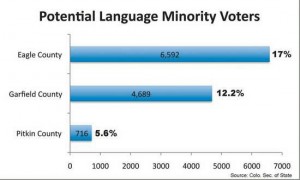 Parties in competition
Parties in competitionParties are facing the same dilemma. Democrats see Latinos, who helped push President Obama to victory in 2008, as a pool of largely untapped voters in this region. Republicans see them as value-based voters they could lure.
Garfield County Democrats have formed a new outreach committee to try to recruit both younger voters and Latino voters.
“If Democrats, or people of good will anywhere, don’t embrace this it’s a terrific loss to our community,” said Jack Real, the chairman of the county party. He said he saw the potential in Latino voters two years ago while campaigning for Obama. He signed up some 11 Latino voters, some of them new citizens who spoke little English but wanted to vote for Obama, he said.
Garfield County Republicans Chairman Ron Roesener said his party has also tried to reach Latinos, but on an individual basis.
“It’s been one-on-one,” Roesener said. “I haven’t been able to get enough that spoke English and were legals together. I don’t mean that to sound politically incorrect or improper but that’s been my experience. I’ve stopped some at the grocery story here, the Clark’s Market (in Battlement Mesa). Almost everyone I stopped, the kids speak English, the parents don’t.”
Glenwood Springs City Councilman Steve Bershenyi, a Democrat, said his unsuccessful county commissioner campaign tried too late to reach Hispanic voters two years ago. Had he done it earlier, he said, he might have closed the 350-vote margin that put him behind Commissioner John Martin, a Republican.
He said his organization held meet-and-greets with Latinos to woo voters, but it should have done more, and sooner.
“One of the things we as a party have to do is to make sure we are absolutely certain that we have a policy in place, not only to reach out to the Hispanic community but to make sure they’re included in the process up to and including candidates,” Bershenyi said.
Both parties, overwhelmingly white, say they’ve seen growing numbers of Hispanics at their events, but it’s been slow. Democrats are eying Latino high school- and college-aged students, young people who often were born here, even if their parents weren’t. In El Jebel, Carbondale, Glenwood Springs and Parachute, white children under 18 are in the minority.
“On our Facebook page we’ve got 50 people on there and maybe four or five who I guess are Hispanic,” said Bryan Fleming, president of the new Young Republicans of Garfield County group.
Fleming said he had never considered targeting Hispanics as a specific group.
“Personally, in a generalization, I would like to have our Hispanic folks involved just in that I think they fall more in line with Republican values,” he said.

by David Frey | Apr 30, 2011 | Boom and Bust, News, The West

Govany Hernandez, of Carbondale, slices meat at Garcia's market in New Castle, serving to the tastes of a Hispanic population that boomed across the valley. In Carbondale, Hispanics make up nearly 40 percent of the population, according to the 2010 census. David Frey photo.
ASPEN JOURNALISM
Aspen Journalism is an independent nonprofit news organization.
When Samuel Garcia opened his grocery store in New Castle a decade ago, it was a sign of changing times. The town’s old general store became a grocery store serving the Latino population at the same time New Castle’s complexion was beginning to change.
By 2010, New Castle’s Hispanic population had grown five times its size in 2000, according to the latest census.
“I can notice the difference,” Garcia said.
New Castle saw the region’s biggest growth in Hispanics, but their numbers are growing throughout the Roaring Fork and Colorado River valleys, marking the biggest current demographic shift in the region. Their actual numbers may be higher than what the census reveals.
Demographers say the census count among Hispanics may be low due to language barriers and fears among illegal immigrants that filling out the form or talking to census workers could lead to deportation.The numbers may have been even higher before the 2010 census was taken. Like other workers, many Hispanics left the Roaring Fork Valley when the recession ground the construction industry and other sectors of the economy to a halt.“A lot of people went back to Mexico or different places in the U.S. because there was no work around,” Garcia said.
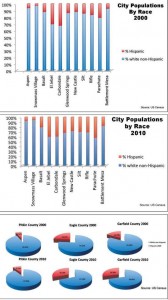
One third Hispanic
Garfield and Eagle counties are nearly one-third Hispanic. Pitkin County is now 9 percent Hispanic; its Hispanic population grew 60 percent over the decade.
In New Castle, the 15th fastest-growing town overall in the state, the Hispanic population grew from a mere 236 in 2000 to 1,282, a 443 percent change.
Hispanics tripled in Silt and Battlement Mesa and doubled in Snowmass Village, Basalt, Glenwood Springs, Rifle and Parachute.
Gains were more modest in El Jebel and Carbondale, which already had large Hispanic populations, but along with Parachute, those communities are now nearly 40 percent Hispanic.
“I think it’s just part of the way the West is growing these days,” said Steve Rippy, manager of Battlement Mesa Service Association, where growing numbers of blue-collar workers, including construction workers and roughnecks, transformed what had been a quiet retirement community.
“The number of Hispanics in the construction industry really boomed in the last decade,” he said.
Changes among children
Hispanic gains are even greater among children. Anglo children are now in the minority in El Jebel, Glenwood and Parachute. They make up less than 60 percent of young people in New Castle, Silt and Rifle.
The local growth in Hispanics was mirrored statewide. Hispanics weren’t the fastest-growing group in the state; Asians outpaced them. But Hispanic numbers are much higher.
“We are more diverse, and we have been becoming more diverse over the past several decades,” said state demographer Elizabeth Warner.
The biggest growth has been among the under-18 age group, Warner said. The last census showed immigrants moving in. This one shows them settling down. “They have kids, form families,” she said. “That’s where a lot of our growth has been taking place.”
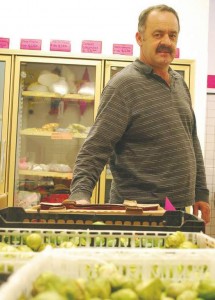
‘The ambassador’
Garcia had plans to open a Mexican restaurant serving cuisine from southern Mexico, where his wife Leticia is from — foods that aren’t on the menu in most Mexican restaurants.
“I tried to open that restaurant last year, but the economy went down, down, and I said, ‘Wait a little bit.’”
He sells basic food, like tacos and burritos, at his lunch counter in the back of the grocery. A few years ago, when the construction industry was booming, the lunch counter was, too.
“Now it’s completely dead,” he said.
Mayor Frank Breslin calls Garcia “the ambassador” of the Latino community.
“If people in general or myself in particular have a question about something or want to get a word in Spanish, we ask Sam,” he said.
Those kind of connections are becoming increasingly important. Breslin said he was surprised to see the census showed the Hispanic population to be so high, but it was no secret that it was growing. He said the town government is seeking a translator to publish its Town Council agendas in Spanish “to invite participation and show that we respect that population.”

by David Frey | Apr 29, 2011 | Boom and Bust, News, The West
ASPEN JOURNALISM
Aspen Journalism is an independent nonprofit news organization.

Vacancy rates rose up and down the valley, due in part to a flurry of new construction followed by a disappearance of jobs. In Battlement Mesa, where vacancy rates tripled, apartments offer move-in specials. David Frey photo.
When the recession ended the boom times of the first decade of the 21st Century, it left the lights out in thousands of unoccupied homes across the Roaring Fork and Colorado River valleys.
Results of the 2010 U.S. Census show vacancy rates climbed from Aspen to Parachute, largely as a result of new construction outpacing demand after the housing bubble burst.
Vacancy rates rose sharpest in western Garfield County, where residents fled due to the recession and vanishing jobs in the gas patch. The situation was worst in Parachute and Battlement Mesa, where nearly one in three homes were left empty.
“Definitely in the state we’ve had overbuilding,” said Elizabeth Garner, state demographer with the Department of Local Affairs. “I think everyone is well aware of that now.“There’s a ton of different issues. There are a lot of people that got into second homes that shouldn’t have been in them. There are a lot of people that got into first homes that shouldn’t have been in them,” she said.
Between 2000 and 2010, vacancy rates tripled in Rifle, Parachute and Battlement Mesa. They doubled in towns from Carbondale to Silt, and in Garfield County as a whole. The county had 2,950 vacant units in 2010, up from 1,107 in 2000. Its vacancy rate soared to 12.7 percent.
Full house or empty hand?
Imagine a population boom and you might picture a lot of full houses. Imagine a growing vacancy rate and you might picture a lot of empty houses. The Roaring Fork and Colorado River valleys got both.
The picture is sharpest in Battlement Mesa, which saw a severe boom-and-bust cycle dictated by an explosion of oil and gas jobs when fuel prices rose, and an implosion when they fell.
“Battlement Mesa, like all the Western Slope and most of the country, was seeing a lot of demand for new housing units,” said Steve Rippy, who, as manager for the Battlement Mesa Service Association, acts as the equivalent of town manager for the unincorporated community.
Over the decade, some 720 new housing units were built in Battlement Mesa to keep up with the demand, from single-family homes to apartments, and townhouses to trailers.
 Gray hair, blue collar
Gray hair, blue collarSubdivisions that had remained empty for decades were built up in a hurry, Rippy said. Empty mobile home lots were rented out. By 2009, Battlement Mesa hit nearly 100 percent occupancy, buoyed mostly by gas workers, he said.
“It was pretty frequent to see a van hauling a U-Haul and these types of things for a while,” Rippy said.
Originally built by Exxon in the 1980s to house oil shale workers, Battlement Mesa found new life as a retirement community after Exxon shuttered its oil shale operations in 1982 — a day remembered as Black Sunday — and left 2,000 workers out of work. It attracted retirees with a golf course, a recreation center and warm, dry weather.
After the natural gas boom, it began attracting energy workers again. Added to that mix were upvalley residents seeking lower home prices. Many of the new residents were Hispanics, whose numbers doubled in Battlement Mesa over the past 10 years, according to census figures.
The retirement community was transforming into a blue-collar neighborhood.
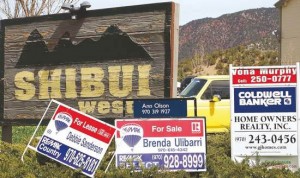
Condominiums such as Shibui West in New Castle provided housing for a growing workforce during boom times, but have emptied during the recession. David Frey photo.
Houses built, jobs vanished
“Over the last 15 years, the reality is, there were probably more people moving here who were not retired,” Rippy said.
When fuel prices fell, many gas jobs disappeared. The recession robbed others of their construction and service. Homes emptied. Construction has ground to a halt.
Now, Battlement Mesa Corp., which owns the development, is offering deals for prospective buyers to move in to apartments. Signs advertise $99 move-in specials.
“You drive through the mobile home park and you’d be shocked at how many of them are empty,” said Battlement Mesa resident Ron Roesener, who counted 11 empty homes in his own neighborhood, many of which were in foreclosure.
Upside-down Parachute
Across the Colorado River, Parachute experienced a similar phenomenon, only more extreme. The town saw 124 new housing units built to handle the expected growth — a big change for a town of about 1,000 people.
By the end of the decade, though, Parachute wouldn’t need any of those homes. In 2010, it had 10 fewer occupied units than it started the decade with, and 134 more vacant homes, according to the census.
The town grew by just 79 people, a 7.9 percent growth rate that was even slower than Aspen’s.
Farther up the valley, the situation only slightly improved.
Rifle went from a 3.6 percent vacancy rate to 11.2 percent.
Silt went from 3 percent to 8.4 percent.
New Castle went from 3.6 percent to 8.6 percent.
Glenwood Springs went from 4.1 percent to 8.1 percent.
Carbondale went from 4.2 percent to 8.8 percent.
The upper valley, which has a historically high vacancy rate due to a large number of second-home owners, was less affected.
Aspen’s vacancy rate grew from 33.3 percent to 40.7 percent. Basalt’s rose modestly from 13.6 percent to 16.3 percent.
Snowmass Village saw its vacancy rate decline, from 50.2 percent to 43.7 percent.

by David Frey | Apr 28, 2011 | Environment, Essays, The West

Colorado River Delta. Pete McBride photo.
NEW WEST
From the rim of the Grand Canyon, the Colorado River below seems both meek and mighty. It looks like a tiny band of water barely visible below millions of years of rock, but it was this river, blasting through fierce rapids with dirt and debris, that carved through a mile of rock like a diamond saw. (more…)
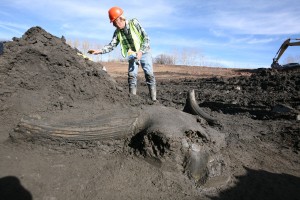
by David Frey | Apr 28, 2011 | Environment, News, The West

Photo courtesy Denver Museum of Nature & Science.
Scientists digging into the peat below Ziegler Reservoir at Snowmass Village, Colorado, found something like an Ice Age zoo last fall. Now, as they prepare to start digging again next month, they also have a puzzle.
Researchers are hunched over in labs piecing together fragments of mastodon skulls and ancient deer antlers. But scientists are also piecing together bigger questions. When did these animals die? Why there? And more importantly, what can they tell us about climate change – then and now? (more…)

 To boosters, it’s almost a magical elixir for the world’s energy woes. To opponents, it’s more akin to snake oil. Even more than most other fossil fuels, oil shale meets with a sharply divided reaction, and after two weeks of public hearings across Utah, Wyoming and Colorado, federal officials have received an earful from both sides.
To boosters, it’s almost a magical elixir for the world’s energy woes. To opponents, it’s more akin to snake oil. Even more than most other fossil fuels, oil shale meets with a sharply divided reaction, and after two weeks of public hearings across Utah, Wyoming and Colorado, federal officials have received an earful from both sides.










